The Ferruginous Hawk (Buteo regalis) commands attention as a prominent and captivating raptor inhabiting the expansive landscapes of North America.
Renowned as the largest hawk on the continent, its imposing size, impressive wingspan, and striking rusty plumage distinguish it in the avian realm.
The name “Ferruginous” aptly describes its earth-toned coloring, adding to the bird’s charismatic presence.
With a preference for open habitats such as grasslands and prairies, this hawk showcases adaptability, often venturing into agricultural areas.
Noteworthy for its unique ground nesting habits and hovering hunting style, the Ferruginous Hawk embodies a harmonious blend of power and grace.
As a species intricately linked to its environment, understanding the Ferruginous Hawk unveils not only its physical magnificence but also its vital role in the ecological tapestry of its native territories. Stay focused.
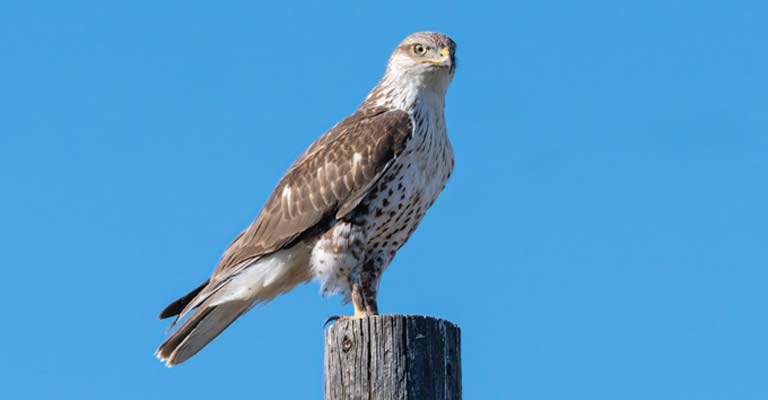
Physical Characteristics of Ferruginous Hawk
The Ferruginous Hawk (Buteo regalis) is a majestic raptor native to North America, known for its distinctive physical characteristics that set it apart from other hawks.
Identifying this specific bird requires a keen eye and an understanding of its unique features. Here are some key points to help identify the Ferruginous Hawk:
Size and Structure
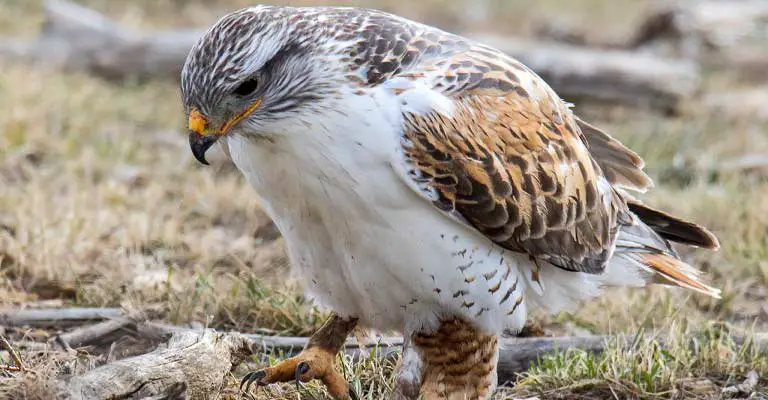
The Ferruginous Hawk is the largest in North America, boasting an impressive wingspan ranging from 45 to 60 inches (114 to 152 cm).
Its overall size can be intimidating, and it has a robust build with broad wings and a short, wide tail.
The plumage varies, but adults typically have a light-colored body with a contrasting dark primary feather pattern on their wings.
Coloration
One of the most noticeable features of the Ferruginous Hawk is its distinctive coloration. Adults often exhibit a light, rusty, or “ferruginous” color on their backs, giving them a warm, earthy appearance.
This coloration is particularly prominent on their legs, earning them the nickname “ferruginous” or “rusty” hawks.
Facial Markings
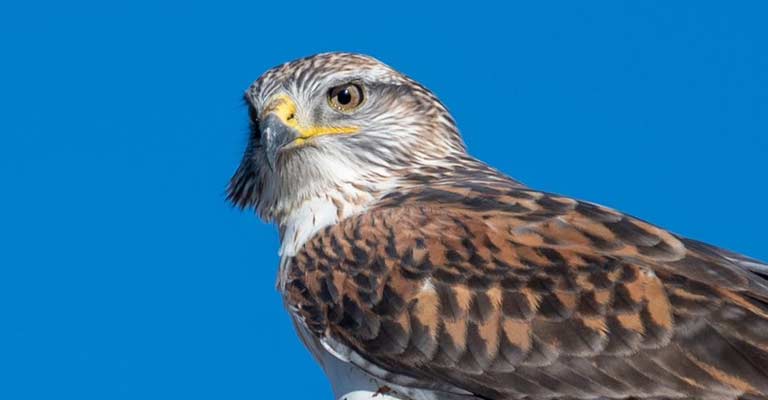
The Ferruginous Hawk’s face is characterized by a pale crown and a distinctive dark comma-shaped mark around the eye, often referred to as a “mustache.”
This facial pattern, combined with a light throat, helps in differentiating it from other hawk species.
Tail Markings
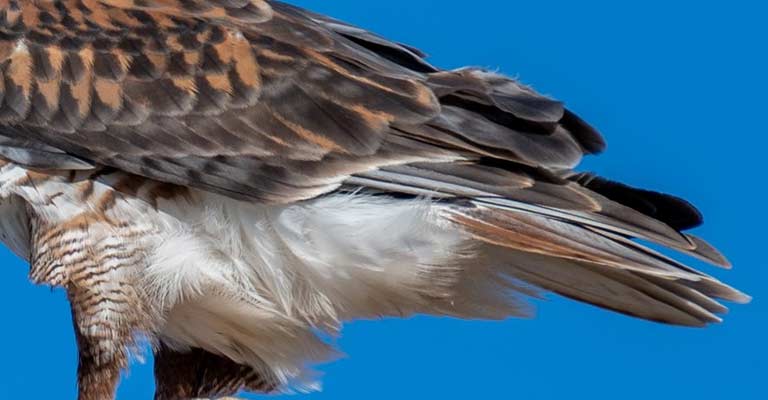
Unlike some other hawks, the Ferruginous hawks typically has a light-colored tail with a broad, dark subterminal band. This band is often more pronounced in younger birds and becomes less distinct as they mature.
The tail plays a crucial role in distinguishing Ferruginous Hawks from other similar species.
Flight Style
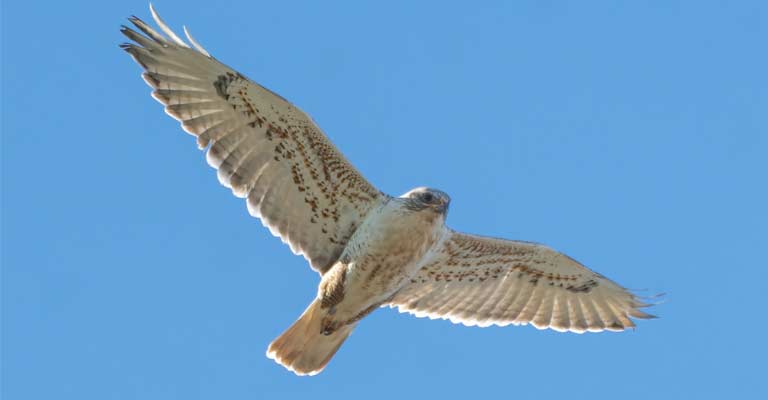
When in flight, Ferruginous Hawks exhibit a distinctive hovering behavior, especially during hunting.
They often hover in a kite-like manner, using their powerful wings to stay in one place as they search for prey.
This behavior is a key characteristic that aids in their identification.
Habitat Preference
Ferruginous Hawks prefer open grasslands, prairies, and desert regions, making their habitat choices another clue for identification.
They often nest on the ground or low structures, such as cliffs, and are known to adapt to a variety of environments, including agricultural areas.
Vocalization
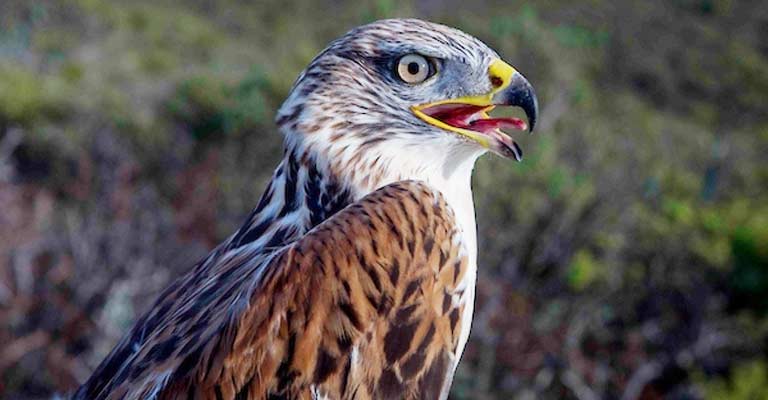
While not as vocal as some other raptors, Ferruginous Hawks do have distinct calls.
Their vocalizations include a series of kleeek or kleeer sounds. Recognizing their unique calls can provide additional confirmation of their presence in a given area.
Behavioral Characteristics
Ferruginous Hawks are known for their hunting behavior, which often involves stalking prey on the ground. They primarily feed on small mammals, such as ground squirrels and prairie dogs.
Observing their hunting techniques and prey preferences can further support accurate identification.
The Ferruginous Hawk’s impressive size, distinctive coloration, facial markings, tail patterns, flight style, habitat preferences, vocalizations, and hunting behavior collectively contribute to a comprehensive set of characteristics for accurate identification.
Birdwatchers and nature enthusiasts can enhance their appreciation of this magnificent species by paying attention to these unique features in the field.
Taxonomy of Ferruginous Hawk
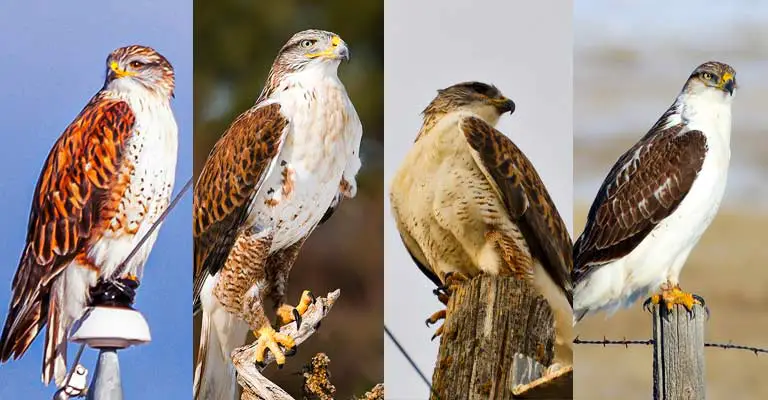
The Ferruginous Hawk (Buteo regalis) is a member of the Animalia kingdom within the Chordata phylum.
| Taxonomic Level | Classification |
| Domain | Eukaryota |
| Kingdom | Animalia |
| Phylum | Chordata |
| Class | Aves |
| Order | Accipitriformes |
| Family | Accipitridae |
| Genus | Buteo |
| Species | B. regalis |
This classification provides a systematic overview of the bird’s place in the broader taxonomy of living organisms.
The Ferruginous Hawk (Buteo regalis) is classified within the Animalia kingdom, Chordata phylum, and Aves class.
As a bird of prey, it belongs to the Accipitriformes order and the Accipitridae family. The genus designation is Buteo, and the specific species is Regalis.
This majestic raptor’s taxonomy reflects its evolutionary relationships and places it among the diverse and fascinating avian species within the broader classification of living organisms.
Ferruginous Hawk Life History
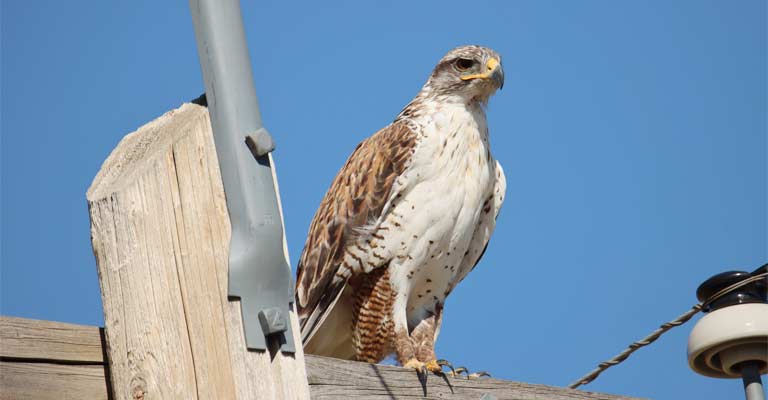
The Ferruginous Hawk (Buteo regalis), a magnificent bird of prey native to North America, boasts not only impressive physical characteristics but also a fascinating life history.
From its dietary preferences to nesting habits, breeding behavior, and challenges posed by diseases, the Ferruginous Hawk’s life is intricately woven into the diverse ecosystems it inhabits.
Let’s delve into the comprehensive life history of this raptor, exploring various aspects of its existence.
Food
The Ferruginous Hawk is a formidable carnivore, primarily preying on small mammals. Its diet includes ground squirrels, prairie dogs, rabbits, and other rodents.
The hawk employs its keen eyesight to spot potential prey from great distances, and its powerful talons and beak allow for efficient capture and consumption.
Habitat
Ferruginous Hawks exhibit a preference for open landscapes, thriving in grasslands, prairies, and desert regions.
Their adaptability is evident in their ability to inhabit both natural and human-altered environments.
They are known to frequent agricultural areas, where the abundance of small mammals provides a readily available food source.
Range Map
The Ferruginous Hawk’s range spans across North America, with breeding grounds extending from the western United States into Canada and parts of Mexico.
Migration patterns vary, with some populations remaining year-round in their breeding territories, while others undertake seasonal movements to exploit different food sources.
Nesting
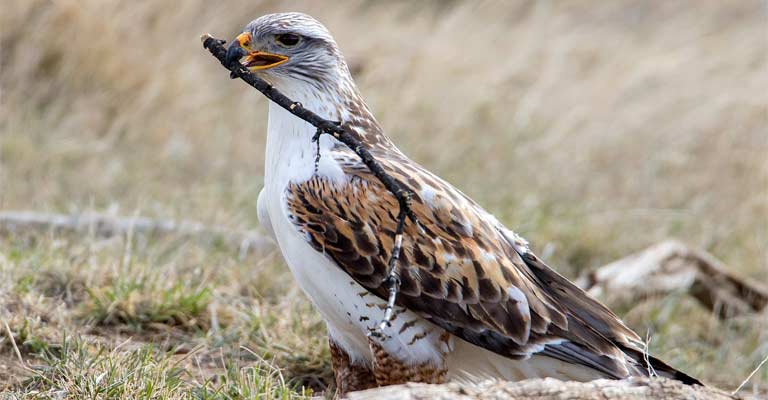
These hawks are ground nesters, choosing locations such as cliffs, rocky outcrops, or even directly on the ground in grassy areas. The nests are constructed from sticks, grass, and other plant materials.
Ferruginous Hawks are known to reuse nests from previous years, reinforcing and repairing them as needed.
| Nesting Details of Ferruginous Hawk | Facts |
| Clutch Size | 2 to 6 eggs |
| Number of Broods | Typically 1 per breeding season |
| Egg Length | Approximately 2.2 to 2.8 inches (5.6-7.1 cm) |
| Egg Width | Approximately 1.7 to 2.1 inches (4.3-5.3 cm) |
| Incubation Period | Around 32 to 36 days |
| Nestling Period | Approximately 39 to 50 days |
| Egg Description | Creamy-white with minimal markings, smooth texture |
| Nesting Location | Ground nests on cliffs, rocky outcrops, or directly on the ground in grassy areas |
| Nest Construction | Sticks, grass, and other plant materials; often reused and reinforced |
| Parental Involvement | Both parents share incubation duties and participate in feeding and care of chicks |
| Fledging Age | Chicks fledge at about 6 to 7 weeks old |
| Post-Fledging Care | Parental care continues for some time after fledging, with parents providing food and guidance |
Understanding the nesting details of Ferruginous Hawks provides valuable insights into their reproductive biology and contributes to conservation efforts aimed at protecting their breeding habitats.
Breeding
Breeding season typically begins in late March or April. Ferruginous Hawks are monogamous, forming strong pair bonds that endure over multiple breeding seasons.
The female typically lays two to six eggs, and both parents share incubation duties.
The chicks fledge after about six to seven weeks, and parental care continues for some time after fledging.
Diseases
Like many bird species, Ferruginous Hawks can be susceptible to various diseases, including avian pox, West Nile virus, and trichomoniasis.
These diseases can impact their overall health and reproductive success, posing challenges to population sustainability.
Treatment
Conservationists and wildlife biologists actively monitor and study Ferruginous Hawk populations to detect and address diseases.
Treatment may involve providing supportive care to affected individuals, implementing measures to reduce disease transmission, and conducting research to develop strategies for long-term health and sustainability.
Conservation
Ferruginous Hawks face threats such as habitat loss, human disturbance, and pesticide exposure.
Conservation efforts focus on habitat preservation, minimizing disturbance in nesting areas, and promoting responsible pesticide use.
Additionally, education and awareness initiatives aim to garner public support for the conservation of this iconic raptor.
The life history of the Ferruginous Hawk is a captivating narrative that intertwines with the ecosystems it inhabits.
From its foraging habits to nesting preferences, breeding behaviors, and the challenges posed by diseases, understanding the intricacies of the Ferruginous Hawk’s life contributes to informed conservation and appreciation of this majestic species.
10 Fun Facts About Ferruginous Hawk
The Ferruginous Hawk (Buteo regalis) is a captivating raptor with a range of fascinating traits and behaviors that make it a unique and interesting species. Here are 10 fun facts about the Ferruginous Hawk:
- Size Marvel: As the largest hawk in North America, the Ferruginous Hawk commands attention with an impressive wingspan ranging from 45 to 60 inches, showcasing its dominance in the skies.
- Rusty Plumage: True to its name, the Ferruginous Hawk displays a distinctive rusty or ferruginous coloration on its back, providing it with a warm and earthy appearance.
- Ground Nesting: Unlike many other hawks, Ferruginous Hawks are ground nesters. They build nests on cliffs, rocky outcrops, or directly on the ground in grassy areas, showcasing their adaptability to diverse environments.
- Hovering Hunters: Ferruginous Hawks are known for their unique hunting style. They often hover in a kite-like manner while searching for prey, utilizing their powerful wings to remain stationary in the air.
- Mustachioed Markings: The Ferruginous Hawk’s facial markings include a distinctive dark comma-shaped mark around the eye, often referred to as a “mustache,” adding a touch of character to their appearance.
- Monogamous Mates: These hawks form strong monogamous pairs that endure over multiple breeding seasons, showcasing a commitment to their partners during the critical phases of reproduction.
- Nomadic Wanderers: Some Ferruginous Hawk populations are known for their nomadic behavior, covering vast distances in search of suitable prey and breeding grounds, adding an element of unpredictability to their movements.
- Vocal Variety: While not as vocal as some other raptors, Ferruginous Hawks have a range of vocalizations, including kleeek or kleeer sounds. These calls are used for communication between mates and during courtship.
- Impressive Speed: In flight, Ferruginous Hawks are not just large; they are also swift. They can reach speeds of up to 50 miles per hour (80 km/h) during their aerial pursuits of prey.
- Conservation Concerns: Despite their impressive presence, Ferruginous Hawks face conservation challenges, including habitat loss, human disturbance, and pesticide exposure. Conservation efforts are essential to ensuring the continued well-being of this majestic species.
The Ferruginous Hawk’s combination of size, coloration, nesting habits, hunting style, and unique features contribute to its status as a captivating bird of prey in the diverse ecosystems it inhabits.
Wrapping Up
The Ferruginous Hawk stands as a remarkable avian species, captivating enthusiasts with its size, hovering prowess, rusty plumage, and distinctive nesting habits.
From its nomadic tendencies to monogamous bonds, this raptor embodies the complexity and beauty of nature’s design.
However, as with many species, conservation efforts are crucial to safeguarding its future amid challenges such as habitat loss.
Appreciating the Ferruginous Hawk goes beyond its physical grandeur; it involves understanding and championing its role in maintaining ecological balance. Thank you so much.